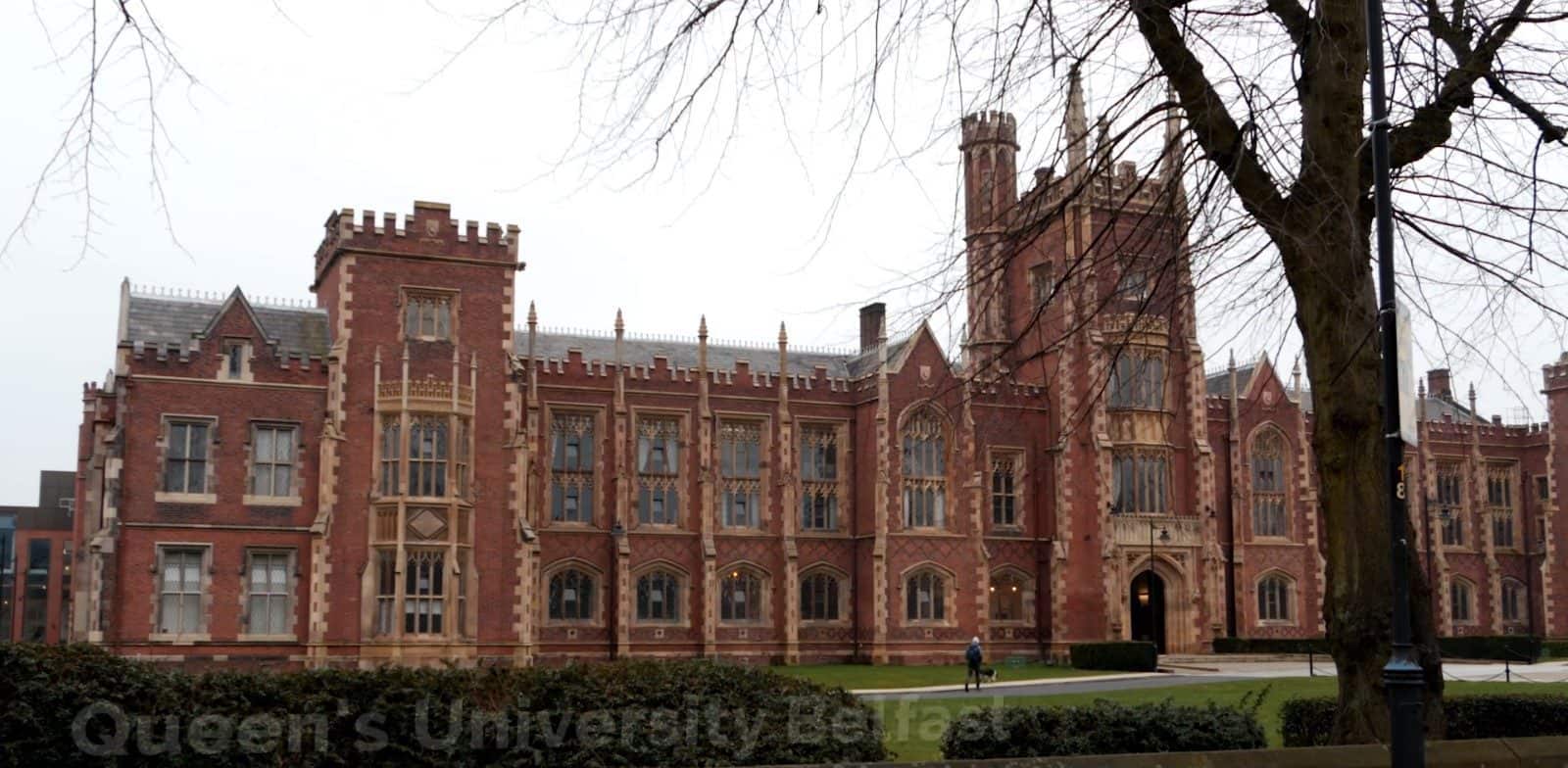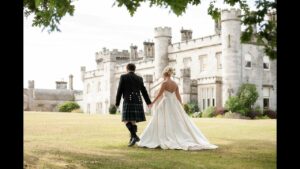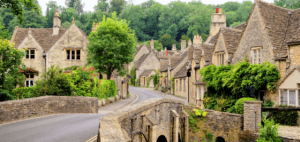Queen’s University Belfast: Past, Present and Future

Updated On: April 20, 2024 by Marise
Queen’s University Belfast is one of the leading universities in the UK, providing world-class education underpinned by world-class research… where did it all begin? Well, keep reading to find out more about this iconic University in Belfast, Northern Ireland.
History of Queen’s University
Queen’s University Belfast was founded in 1845 by Queen Victoria’s Royal Charter. It is “the UK’s 9th oldest University” (Queen’s University Belfast). Opening in 1849 as “Queen’s College, Belfast”. It was purposely designed to be a non-denominational University, the opposite to Trinity College Dublin, which was controlled by the Anglican Church.
It was established along with “Queen’s College Cork” and “Queen’s College Galway”. Then in 1908, this structure was disbanded and it became Queen’s University Belfast and the National University of Ireland. In 1909 there were around 600 students, mostly drawn from the historic nine counties of Ulster. In the present day, there are approximately 23,000 students from the UK and Ireland and more than 80 other countries. Queen’s Belfast is a major part of Northern Ireland and exists as a centre of international-standard education and research.
The Lanyon Building and the Entrance Hall
Queen’s University Belfast is one of the cities most iconic and stunning architectural pieces. The Centrepiece of Queen’s University is called The Lanyon Building which opened in 1849 and is named after its architect Sir Charles Laynon.
Shockingly, this stunning piece of architecture is not as stunning as the original plans intended! Budget limited the original plans. This part of Queen’s Estate is the most recognisable and is often used in tourist videos and posters to showcase the City. His Design of the building was influenced by the Gothic and Tudor character of the great medieval universities, particular Magdelen College, Oxford. Laynon has also designed a few other noticeable landmarks in the city such as Customs House, Belfast Castle and Crumlin Road Gaol. The campus also contains over 100 buildings that are listed as being a special architectural and historic merit.
Today, Queen’s University Belfast, has over 300 buildings, but the Lanyon remains the main building, arguably, one of the most beautiful buildings in Belfast. Established architect Sir Charles Lanyon was appointed to plan this building. Most of the original plans were drawn up by William Henry Lynn, apprentice of Charles Lanyon.
Many of the original details not used for the building can be found in William Henry Lynn’s plans. These original plans cost 30 per cent over the budget. The main entrance was originally to feature a grand Gothic door and window on one wall leading to an examination hall. This was one of the first cuts in the plan to save money. Instead, a simpler window was designed by J E Nuttgens in 1939. It was not added until after WWII.
Sir Charles Lanyon’s final design, sandstone and soft red brick, reflects the culture of the time, the historical architecture creates an appearance of authority. The Lanyon building is surrounded by grass, both at the front and in the quadrangle.
The Lynn Hall
Constructed between 1866 and 1868, the Lynn hall was the original University Library. Named after the architect who designed it, William Henry Lynn. He designed it in a neo-gothic style, very famous at the time. The Library opened in 1868 due to the rising number of students. Later Lynn extended the building to the east in 1911, completed in 1913.
The Great Hall
Before the Lynn Hall was funded, the Great Hall functioned as both an examination hall and the library. Taking inspiration from medieval halls of Oxbridge colleges: the oriel window, a raised dais and a fireplace for the top table. However, similar to the Lanyon, suffered due to lack of funds: the gallery was never built and simple panelling was designed.
Today
Queen’s University Belfast’s current intake is 23,000 students from all over the world. The campus is ever growing: The McClay Library was opened in 2009; two new student accommodation buildings opened during Summer 2018 in Belfast city centre; and the new School of Biological Sciences opening during 2019. With much success, Queen’s University Belfast will continue to grow each year both in student intake and geographically.
The Lanyon Building and Main Entrance
The grand centrepiece of this hall is Pio Fedi’s statue of Galileo which was added in 2001. From the quadrangle, you can see the only remaining part of the original design, the year “1848” marked on the Lanyon’s south wing. The south wing is the only part of the original design.
The Lynn Hall
In 2009, the library moved to the new McClay Library and before becoming the graduate school underwent renovation in 2015. Now, as the graduate school, it is a modern space however it still contains many of its original designs such as the vaulted ceiling, gothic arches and gargoyles. There remains a memorial plaque for the architect William Henry Lynn.
The Great Hall
In 2000 the Great Hall was restored by Consarc Conservation, architects. The restored organ from Christchurch was installed and above the fireplace a bronze plaque in memory of Thomas Hamilton (first president of the University).
The restoration received a RIBA Award in 2001. It is now used as a refectory, examination hall and a venue for formal occasions, conferences and exhibitions. The walls are covered with portraits of important people such as Queen Victoria (founder) and Nobel Laureate Seamus Heaney.
Famous Faces
Due to Queen’s University Belfast’s proud history and ever-growing facilities, it is not surprising that many famous people have studied at this campus.
Nobel Laureate Seamus Heaney: An Irish writer, studied at St Columb’s College, Derry/ Londonderry, before attending, graduating and lecturing at Queen’s University Belfast.
Liam Neeson: An Irish actor. Studied physics and computer science at Queen’s University Belfast, however, he was removed from Queen’s University Prospectus in March 2019.
Mary McAleese: Graduated with a Law degree from Queen’s University Belfast in 1973. In 1997 she was voted the eighth President of Ireland. The only person from Northern Ireland to hold the Irish Presidency, the first from Northern Ireland and the second-ever female.
Annie Mac: Studied English at Queen’s University Belfast. She is an Irish DJ and television presenter.
Lisa McGee– Irish stage and screenwriter, born and raised in Derry/ Londonderry. Drama graduate from Queen’s University Belfast in 2002.
Máire O’Neill, Meng 1999 – Won British Female Inventory in 2007: She is widely recognised as one of Europe’s leading cryptography experts to enhance data security throughout the world. She is also one of only five engineers to win the Royal Academy of Engineering Silver Medal for her contribution to society in 2014.
Patrick Kielty, Bssc Psychology 1992 – He is a stand-up comedian and well known for his TV presenting. Patrick is one of Northern Ireland most recognised and celebrated entertainers.
Seamus Healy, BA English 1961– He is known as one of the worlds best-known poets and his work has been highly acclaimed. Besides being an Irish poet he was a playwright, translator and even lectured in Queen University on Modern English Literature. Seamus was also the winner of the Nobel Peace Prize in 1995 for Literature.
Let us know if you have ever been a student at Queen’s University and what your experience was like in the comments below.
Other blogs you may like: St. Georges Market | Laverys Belfast | Belfast Castle | Good Vibrations in Belfast | Botanic Gardens, Belfast | St. Anne’s Cathedral






